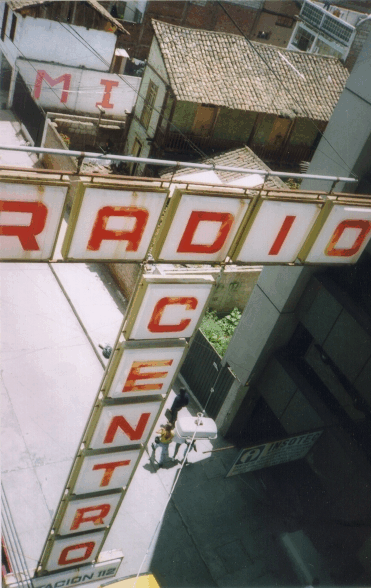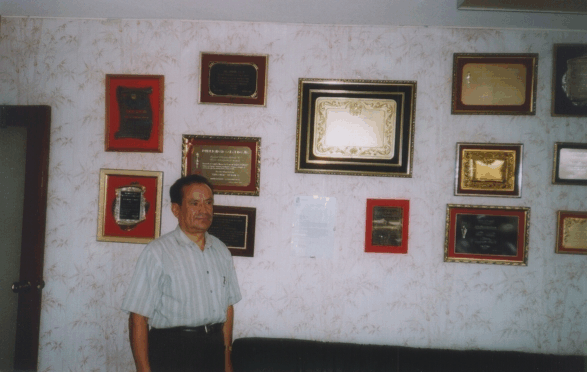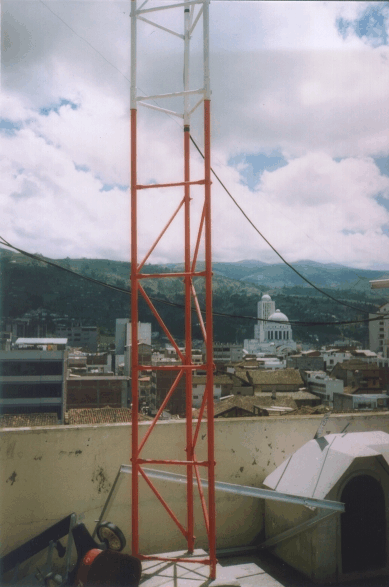|
|
|
- |
|
Ambato is a thriving city
just 4 hours south of Quito and sits on a ridge between a few steep hills
and a valley that drops off sharply. Its residents consider themselves
to be resilient and offer the fact that their city was rebuilt after a
devastating earthquake in 1948 as evidence.
 After
driving blindly through the streets with a taxi driver who claimed he didn’t
know where Radio Centro is, we stumbled onto
its huge sign sticking out of a four-story building. Elsa and I proceeded
to the third floor, where the main offices are, however, the secretary
told us that the director, Luis Gamboa, was out. As we debated whether
or not to stick around, Luis walked in and lit up as soon as he heard that
I was visiting from Washington. He ushered us into his huge office ordained
with numerous plaques, statues, pennants and certificates. “So you wrote
to us before but never got a reply?” He asked me as the three of us sat
on his leather sofas. After
driving blindly through the streets with a taxi driver who claimed he didn’t
know where Radio Centro is, we stumbled onto
its huge sign sticking out of a four-story building. Elsa and I proceeded
to the third floor, where the main offices are, however, the secretary
told us that the director, Luis Gamboa, was out. As we debated whether
or not to stick around, Luis walked in and lit up as soon as he heard that
I was visiting from Washington. He ushered us into his huge office ordained
with numerous plaques, statues, pennants and certificates. “So you wrote
to us before but never got a reply?” He asked me as the three of us sat
on his leather sofas.
 “No,”
I told him. “I got a letter from you almost ten years ago!” The feeling
was odd for me at first to be chatting casually with someone who for so
long had simply been a "verification signer" - a signature at the bottom
of my Radio Centro verification letter. How easily we forget that
real people open reception reports and reply to our mail. “No,”
I told him. “I got a letter from you almost ten years ago!” The feeling
was odd for me at first to be chatting casually with someone who for so
long had simply been a "verification signer" - a signature at the bottom
of my Radio Centro verification letter. How easily we forget that
real people open reception reports and reply to our mail.
We made small talk for a few minutes, discussing
Washington, Ecuadorian food and politics, and the upcoming World Cup soccer
tournament, and then he proceeded to explain the station’s history.
Radio Centro has been on MW for 37 years, where
it is now active on 1130 kHz. Its SW outlet began in 1987 and has sat on
3290 kHz ever since, broadcasting from 2300 to 1200 GMT. Luis Gamboa responds
to the “mountain” of reports that are received each week with a verification
letter and whatever else may be lying around. Sadly, the station no longer
has pennants available, however, lapel pins and stickers have recently
been made. He told me that the foreign mail brings pride to the station,
especially since it's a good marketing tool: evidence for potential advertisers
that their paid ads on Radio Centro can be heard worlwide.
While touring the station’s facilities, I was asked
to take a minute to record a promotional announcement for their SW service
in their production studio. After all, I did come to Ambato just to see
this station! I was then brought around to the FM outlet, Bonita FM on
93.7 MHz, which is the flagship station of a larger FM network with its
name.
 Radio
Centro's SW service shares its comfortable studio with the MW outlet. Although
foam is usually used as sound insulation, they use thick wood – giving
the facilities a nice ambience. Announcers sit in a corporate-like conference
room while on the air, separated from the producer by a window. All of
the station’s equipment (processors, compressors, and 8-channel mixer)
is mounted on a desk and on the wall, giving more of an appearance of a
recording studio than a radio station. Radio
Centro's SW service shares its comfortable studio with the MW outlet. Although
foam is usually used as sound insulation, they use thick wood – giving
the facilities a nice ambience. Announcers sit in a corporate-like conference
room while on the air, separated from the producer by a window. All of
the station’s equipment (processors, compressors, and 8-channel mixer)
is mounted on a desk and on the wall, giving more of an appearance of a
recording studio than a radio station.
 Elsa
and I went back to the managements office to thank Luis for his staff’s
hospitality, and he immediately offered to take us up to the roof and see
a view of the city. We headed up the stairs to the top floor, passing by
a greenhouse, and were promptly met by Radio Centro’s guard dog Michael.
The roof offered a nice view of the city with all its hills and churches,
seen through satellite dishes and the studio-transmitter VHF antenna. I
took a few pictures and then thanked Luis again since Elsa and I needed
to get to Riobamba before sunset. Of course, Elsa also needed her
Castillian food before we jumped on another bus. Elsa
and I went back to the managements office to thank Luis for his staff’s
hospitality, and he immediately offered to take us up to the roof and see
a view of the city. We headed up the stairs to the top floor, passing by
a greenhouse, and were promptly met by Radio Centro’s guard dog Michael.
The roof offered a nice view of the city with all its hills and churches,
seen through satellite dishes and the studio-transmitter VHF antenna. I
took a few pictures and then thanked Luis again since Elsa and I needed
to get to Riobamba before sunset. Of course, Elsa also needed her
Castillian food before we jumped on another bus.
|

